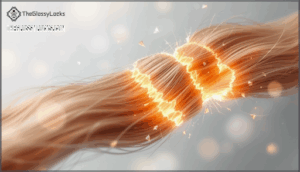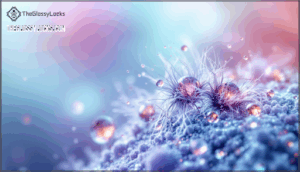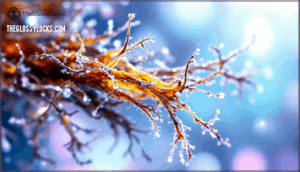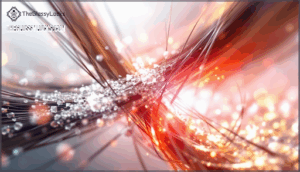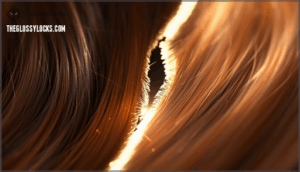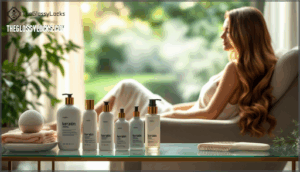This site is supported by our readers. We may earn a commission, at no cost to you, if you purchase through links.
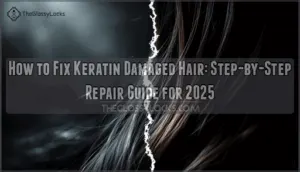
When heat and chemicals compromise your hair’s structural integrity, the damage manifests as breakage, dullness, and persistent frizz that no amount of styling can tame.
The good news is that keratin-damaged hair isn’t beyond repair, and with the right approach, you can rebuild strength from the inside out.
Table Of Contents
- Key Takeaways
- Signs Your Hair is Keratin Damaged
- Why Keratin Treatments Damage Hair
- Immediate Steps to Minimize Further Damage
- Advanced Repair Methods for Severely Damaged Hair
- Long-Term Tips for Healthier, Stronger Hair
- Frequently Asked Questions (FAQs)
- How often should I use a triple moisture hair mask?
- What are the benefits of using a good quality nourishing shampoo?
- What alternatives are there to keratin treatments?
- What are the effects of using too much heat when styling my hair?
- What other ways can I protect my hair from damage?
- Can keratin treatments work on already damaged hair?
- How long until hair fully recovers naturally?
- What foods or supplements support hair repair?
- Are there keratin-free alternatives for smoothing hair?
- Can you reverse keratin damage without cutting hair?
- Conclusion
Key Takeaways
- Keratin treatments can cause severe damage through high heat application, formaldehyde exposure, protein overload, and excessive manipulation, leading to breakage, dullness, and weakened hair structure that requires immediate intervention to prevent further deterioration.
- Recovery demands stopping all heat styling and chemical treatments while switching to sulfate-free cleansers, gentle handling, and protective hairstyles—essentially putting your hair in damage control mode before attempting any repair work.
- Advanced repair strategies like hydrolyzed keratin treatments, hyaluronic acid with ceramides, regular trims, and professional bond-rebuilding services (such as Olaplex) can restore strength and moisture retention in severely compromised strands over a 3-6 month timeline.
- Long-term hair health requires consistent nourishing routines, minimal heat and chemical exposure, protective styling habits, and monitoring progress through visual assessments—treating prevention as seriously as the initial repair.
Signs Your Hair is Keratin Damaged
Keratin damage can show up in your hair in more ways than you might expect. Knowing what to look for is the first step toward getting your hair back on track.
Here are the most common signs your hair may be struggling after a keratin treatment.
Dullness and Dryness
It’s surprisingly common to notice your hair losing its shine and feeling dry after a keratin treatment, even if you followed every step carefully. Hydration importance can’t be overstated—damaged hair often lacks natural oils.
Humectant use, scalp health, and addressing vitamin deficiencies all play a role. Reach for a moisturizing shampoo to start restoring hair health and counter persistent hair dryness.
Increased Breakage and Split Ends
Once dryness sets in, you might notice your hair snapping more easily and those pesky split ends creeping up along the lengths. Breakage Causes often stem from keratin treatment damage, disrupting Protein Balance and weakening bonds.
Repairing damaged hair means prioritizing Hydration Importance, increasing Trimming Frequency, and focusing on Split End Prevention. Consistent trims and bond-rebuilding treatments help restore hair strength.
Frizz and Flyaways
Humidity Effects and Environmental Factors only make frizz and flyaways worse, especially when your hair’s Hydration Balance is off. Static Buildup and Product Buildup can leave strands sticking out in every direction, undermining your hair repair efforts.
If you’re noticing more frizz after a keratin hair treatment, damaged hair may need targeted moisture—not just another smoothing serum.
High Porosity and Weakness
High porosity means your hair struggles with moisture retention and protein balance, leaving it prone to breakage and weakness. Damaged cuticles can’t seal in hydration, so even deep conditioners may fall short.
Focus on cuticle repair and elasticity improvement, using products that strengthen strands and restore hair strength. Addressing brittle hair early aids lasting hair repair and resilience.
Why Keratin Treatments Damage Hair
Keratin treatments promise smoother, shinier hair, but they can come with a price. There are a few key reasons why these treatments might leave your hair feeling worse for wear. Here’s what you should watch out for next.
High Heat Application
Excessive heat, especially during keratin treatments, can cause hair damage by breaking down the internal structure of each strand. Without proper temperature control or quality tools, you risk heat damage, leading to hair breakage and weakened bonds.
Always use heat protectants and mindful application techniques to minimize keratin treatment damage and support hair bond rebuilding for healthier, resilient hair.
Chemical Exposure (Formaldehyde)
Although keratin treatments promise smoother hair, high formaldehyde levels can trigger exposure symptoms like scalp irritation, eczema, and even hair loss. Over time, chemical damage may lead to weakened strands and long-term effects, including increased cancer risk.
Regulatory actions urge caution, so prioritize safer alternatives and focus on hair recovery strategies to repair keratin treatment damage effectively. Some products labeled "formaldehyde free" may still contain high levels, so be wary of hidden formaldehyde risks.
Protein Overload
While chasing stronger strands, you might find that too much protein can leave your hair feeling stiff, brittle, and surprisingly fragile. Protein overload from keratin treatment damage often leads to:
- Hair stiffness and breakage from protein imbalance
- Product buildup that disrupts hair moisture
- Scalp issues—itching or flaking—when avoiding overload isn’t prioritized
Balance is key to hair damage and repair.
Excessive Hair Manipulation
Between the repeated flat ironing, combing through wet sections, and constant tugging during the application process, keratin treatments put your strands through a physical workout they weren’t built to withstand. This hair manipulation creates friction that weakens your hair’s structure, similar to over-styling effects from tight braids or extension stress.
Poor combing habits during treatment increase hair breakage, leaving you with fragile strands that need dedicated hair repair treatments to bounce back.
Immediate Steps to Minimize Further Damage
Once you notice signs of keratin damage, your first priority is stopping the harm in its tracks.
The following steps will help you protect your hair while it begins to recover. Think of these as your emergency protocol—simple changes that make a real difference.
Stop Heat Styling and Chemical Treatments
Your hair’s been through enough already, so the first rule of recovery is simple: put down the flat iron and step away from the salon chair. Heat styling amplifies keratin treatment damage and worsens hair breakage, while additional hair processing treatments create a vicious cycle your strands can’t escape.
Instead, embrace natural texture through air drying techniques and gentle alternatives that prioritize hydration focus and scalp health.
Use Gentle, Sulfate-Free Cleansers
Sulfate-laden shampoos strip your already compromised hair like sandpaper on silk, removing what little moisture and protein your strands have left to retain. Switch to sulfate-free cleansers that respect pH balance and prioritize gentle cleansing—your hair wash day routine becomes a hydration boost instead of another assault on weakened cuticles.
Look for formulas containing:
- Coconut-derived surfactants that cleanse without stripping natural oils
- Amino acids to rebuild protein structure and minimize hair breakage
- Aloe vera or glycerin for immediate moisture replenishment
- Tea tree or peppermint oil to maintain scalp health without irritation
- Panthenol (Pro-Vitamin B5) to penetrate and strengthen damaged strands
These sulfate alternatives transform hair care after keratin treatment from damaging to restorative.
Avoid Tight Hairstyles and Rough Handling
Beyond gentle cleansing, how you treat your hair determines whether those fragile strands survive or snap off at the slightest tension.
Embrace Gentle Detangling with soft brushes, starting from the ends upward. Wear loose styles instead of tight ponytails, and wrap hair in silk scarves overnight.
Try scalp massage to boost circulation without pulling. These hair care recommendations directly reduce hair breakage during your hair health recovery process, protecting weakened strands from hair damage and repair setbacks through mindful hair styling and manipulation.
Advanced Repair Methods for Severely Damaged Hair
When your hair is badly damaged from keratin treatments, you need more than basic care—you need intensive repair strategies.
The following methods target deep structural damage, rebuild strength from within, and restore resilience to severely compromised strands.
Here’s what works when standard approaches aren’t enough.
Protein and Keratin Rebuilding Treatments
When damage runs deep, protein treatment becomes your main line of defense. Hydrolyzed keratin penetrates the cortex, rebuilding hair bonds from within and increasing tensile strength by up to 86%. Apply these treatments every 4–6 weeks to avoid protein overload while steadily restoring hair structure. Salon protein treatments strengthen hair, making it more resilient.
- Hydrolyzed Keratin repairs internal damage, boosting breaking force by 136% in severely compromised strands
- Enzyme Crosslinking strengthens keratin-serine bonds, reducing brittleness and improving fracture resistance
- Amino Acids fill structural gaps, increasing interaction forces by 25% and enhancing cuticle cohesion
- Treatment Frequency matters—balance protein with moisture to prevent rigidity and maintain flexibility
- AI Microscopy now tracks micro-level keratin restoration, confirming shaft strengthening with 20% greater accuracy
Incorporating Hyaluronic Acid and Ceramides
After you’ve fortified your hair’s internal structure with protein, moisture retention becomes the next piece of the puzzle—and that’s where hyaluronic acid and ceramides step in.
HA benefits include pulling moisture deep into the cortex, while ceramide function focuses on barrier repair, sealing the cuticle to lock hydration in. Together, they prevent moisture loss in damaged hair, supporting the hair health recovery process.
Look for hair moisturizing treatments combining both ingredients for the best results in your hair treatment options.
Regular Trims to Remove Split Ends
Once your hair can retain moisture properly, it’s time to cut away the damage that’s beyond saving. Split ends won’t mend themselves—they’ll continue splitting upward, causing hair breakage and worsening hair damage and repair efforts. Schedule trims every 6-8 weeks using these guidelines:
- Trim Frequency: Every 6-8 weeks prevents split end progression
- Proper Shears: Sharp haircutting scissors prevent tearing and further damage
- Trimming Technique: Cut 1/4 to 1/2 inch above visible splits
- Home Trimming: Twist small sections to reveal damaged ends for precise removal
Professional Salon Treatments
For damage that runs deeper than your bathroom cabinet can control, specialized salon treatments deliver concentrated repair with techniques you can’t replicate at home. Professional services like Olaplex treatment rebuild broken bonds, while deep conditioning and protein masks target the hair health recovery process through sophisticated formulations. Here’s what works:
| Treatment Type | Key Benefits | Frequency |
|---|---|---|
| Bond Rebuilding (Olaplex) | Repairs internal structure, reverses hair damage and repair concerns | Every 4-6 weeks |
| Salon Keratin (Restorative) | Smooths without harsh chemicals, aids hair restoration | Every 3-4 months |
| Intensive Protein Masks | Strengthens weakened strands, treats protein loss | Bi-weekly to monthly |
| Scalp Health Treatments | Promotes new growth, improves follicle condition | Monthly |
| Custom Deep Conditioning | Maximizes moisture retention after keratin treatments | Every 2-3 weeks |
These hair treatments work because trained stylists assess your specific damage pattern and adjust formulations accordingly.
Long-Term Tips for Healthier, Stronger Hair
Repairing keratin damage is just the beginning—keeping your hair healthy long-term requires consistency and smart habits. Once you’ve rebuilt your hair’s strength, you’ll want to protect that progress and prevent future damage.
Here’s how to maintain healthier, stronger hair moving forward.
Establishing a Nourishing Hair Care Routine
Building a solid hair care routine is like laying the foundation for a house—skip the basics, and everything else crumbles. Focus on gentle cleansing with sulfate-free shampoos, deep conditioning weekly for hydration importance, and scalp health through regular massage with natural oils.
Consistent care protects your strands during the hair health recovery process, turning your hair nourishment efforts into visible results over time.
Limiting Future Chemical and Heat Exposure
If you’ve put your hair through the wringer once, the smartest move is learning when to step back and give it a real chance to breathe. Here’s how to dodge future hair damage from heat and chemicals:
- Swap hair straighteners for heatless styling techniques like braiding damp hair overnight
- Apply heat protectants religiously when styling is unavoidable—they’re non-negotiable
- Explore chemical alternatives such as air-drying and natural styling methods
- Make routine adjustments prioritizing hydration importance through leave-in conditioners
- Shield strands when protecting hair sun exposure with UV-blocking sprays or hats
Your hair will thank you for the restraint.
Protective Hairstyles and Sleeping Habits
The way you wear your hair to bed—or how you pin it up during the day—can either undo all your repair work or act like a nightly insurance policy against more breakage.
Switch to satin pillowcases or silk scarves to reduce friction that causes split ends. Try loose braids for your nighttime routine, and practice gentle detangling before bed.
These hair care tips provide essential hair protection while you sleep.
Monitoring Progress and When to Seek Help
Tracking your hair’s Damage Timeline is like watching a plant grow—you need consistent check-ins to spot real change. Take monthly photos for Visual Assessment and monitor texture, shine, and breakage at home. If split ends persist after three months or you notice patchy loss, schedule a Professional Evaluation.
Home Monitoring combined with Quantitative Analysis of shedding rates reveals whether your protein overload in hair is resolving or if hair damage and repair needs professional intervention during your hair health recovery process.
Frequently Asked Questions (FAQs)
How often should I use a triple moisture hair mask?
Your hair’s porosity level determines mask frequency—high porosity damaged hair benefits from weekly applications, while low porosity hair needs treatment every two weeks.
Ingredient synergy matters; layering techniques and product recommendations should align with your hair health recovery process.
What are the benefits of using a good quality nourishing shampoo?
You’ve probably noticed how drugstore shampoos strip your hair, leaving it squeaky but brittle. Quality nourishing shampoos offer Hydration Boost and Gentle Cleansing without harsh sulfates, promoting Scalp Health while providing Damage Prevention.
They boost shine, support the hair health recovery process, and deliver essential hair nourishment and protection your strands desperately need.
What alternatives are there to keratin treatments?
Consider smoothing serums, Hair Botox, protein treatments, natural oils, or relaxer alternatives.
Natural hair treatments like Avocado and Egg Mask recipes can nourish strands without harsh chemicals, offering gentler hair damage remedies.
What are the effects of using too much heat when styling my hair?
Excessive heat styling breaks down your hair’s protein structure, leading to brittleness and hair breakage over time. You’ll notice color fade acceleration, increased dryness, and scalp health impact from repeated thermal stress.
Making heatless styling essential for damaged hair recovery.
What other ways can I protect my hair from damage?
Beyond heat and chemicals, focus on scalp health, hydration importance, and dietary impact for stronger hair.
Use silk scarves for sun protection, avoid tight styles causing hair breakage, and maintain gentle hair care recommendations supporting overall hair health.
Can keratin treatments work on already damaged hair?
Ironically, slapping more keratin on already damaged hair is like pouring water into a cracked glass—it won’t stay. Damaged hair has a lower damage threshold and can’t absorb treatment effectively, often worsening hair breakage.
Pre-treatment care and alternative solutions work better for the hair health recovery process.
How long until hair fully recovers naturally?
Recovery timelines vary widely based on damage severity and individual variation. Natural texture usually returns in three to six months, but severe hair damage and breakage may need longer.
Treating hair breakage consistently through a proper hair health recovery process accelerates restoration.
What foods or supplements support hair repair?
Studies show biotin deficiency affects just 2% of the population, yet supplements fly off shelves.
Focus on protein intake—lean meats, eggs, legumes—plus omega-3s from fish, collagen peptides, and vitamin-rich greens. These essential nutrients support your hair health recovery process through nourishment and protection from within.
Are there keratin-free alternatives for smoothing hair?
Yes, several keratin-free alternatives smooth frizzy hair effectively. Glyoxylic acid treatments, amino acids, enzymatic treatments, and plant extracts like sugarcane extract improve hair manageability and smoothness without traditional keratin’s risks.
Can you reverse keratin damage without cutting hair?
Reversing Keratin Damage without cutting hair is absolutely possible through targeted hydration strategies and protein-rebuilding treatments.
Studies show keratin K31 boosts hair elasticity restoration by 86%, proving Non-Cutting Solutions work when you focus on moisture retention and damage prevention.
Research shows keratin K31 can restore hair elasticity by 86%, proving you can repair damage without cutting if you prioritize moisture and protein balance
Conclusion
The path to repairing keratin-damaged hair isn’t instant, but consistency rewrites the story. As you rebuild protein bonds and shield strands from further stress, you’ll notice resilience returning—first in texture, then in strength.
Learning how to fix keratin damaged hair means recognizing that recovery is gradual, not magical. Each protective choice compounds over weeks, turning fragile strands into hair that can withstand brushing, styling, and life without breaking.
Trust the process, give your hair the time it needs, and you’ll reclaim the vitality that chemicals temporarily took away.
- https://pmc.ncbi.nlm.nih.gov/articles/PMC6218806/
- https://haircolorist.blog/2024/09/16/keratin-treatments-in-2024/
- https://pubmed.ncbi.nlm.nih.gov/30861299/
- https://www.sciencedirect.com/science/article/pii/S2667137923000310
- https://www.nexxus.com/us/en/haircare-101/how-does-keratin-help-damaged-hair.html


